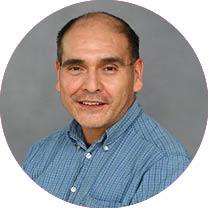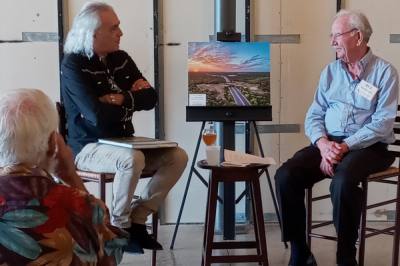A newly released book contains essays and photos chronicling daily life in one of north San Antonio’s biggest public parks—from the flora and fauna that thrive there to humans who visit for recreation.
Developed by local nonprofit Phil Hardberger Park Conservancy, “Phil Hardberger Park: A Story in Photographs” includes an introduction from the park’s namesake who as San Antonio mayor in the 2000s led efforts to turn 330 acres of former dairy farmland into a sprawling urban park.
The conservancy held a mixer June 9 at the park’s Urban Ecology Center, with Hardberger himself appearing alongside local author John Phillip Santos, who contributed to the new book.
The event showcased displays of eight photos featured in the book, copies of which were sold and provided to mixer attendees who secured autographs from Hardberger and Santos.
Conservancy officials said they commissioned three photographers—Al Rendon, Steve Slate and Justin Moore—in 2019 to capture images of typical life inside Phil Hardberger Park, as well construction of Robert Tobin Land Bridge, which spans Wurzbach Parkway and links both sides of the park.
Several other photographers are park visitors who offered their pictures for inclusion in the book, the conservancy said.
Santos said he could remember growing up not far from what been the Voelcker family dairy farm in north central San Antonio, between Castle Hills and Shavano Park.
Hardberger said he initially knew little if anything about the former farm when he was mayor between 2005 and 2009.
But when a group of residents asked the city to act and preserve the former farm, and save it from development, Hardberger said he quickly moved to get the city to secure the land.
Hardberger said he learned much about the Voelcker family’s history, and he learned to embrace the wealth of virtually untouched acreage. The city acquired the land for $50 million, and designated it a public park, Hardberger said. Hardberger said he especially likes the amount of trees around the park.
“It’s a lot more forested than what you’d expect to see on a dairy farm” Hardberger said.
According to Hardberger, it was important to him and other park advocates that much of the land remain in a natural state so that a bulk of Hardberger Park could serve as an example of “living history.”
“We wanted to preserve the way God made [the park]. You can’t perfect nature’s works,” Hardberger said.
As a nonprofit, the conservancy raises funds to help maintain Hardberger Park and provide a variety of nature education programming for all ages there.
Hardberger himself and the conservancy were instrumental in raising $10 million in private donations and grants toward a $23 million total project to build a unique park land bridge, which opened to the public in December 2020.
Hardberger said it was a challenge to face criticism from many residents who chided the city for including a $13 million proposal in the city’s $850 million bond that voters eventually approved in 2017. The city wound up spending $15.5 million in public funds on the land bridge project.
The bond proceeds were used to help build the land bridge, which Hardberger described as something that could bring people together and reflect a can-do attitude in San Antonio.
“Some people were looking at the minuses, and not the pluses. I thought ‘Let’s build something in San Antonio that will outlast us’,” Hardberger said.
Hardberger said he supports efforts by the park conservancy, other groups and individuals to help preserve Hardberger Park and make it accessible to more people.
“I think we have to have programs that captivate the imagination and memories of our youth,” he added.
Proceeds of sales of “Phil Hardberger Park: A Story in Photographs” go to benefit the park conservancy. Copies are available for sale at The Twig Book Shop and Nowhere Bookshop.






